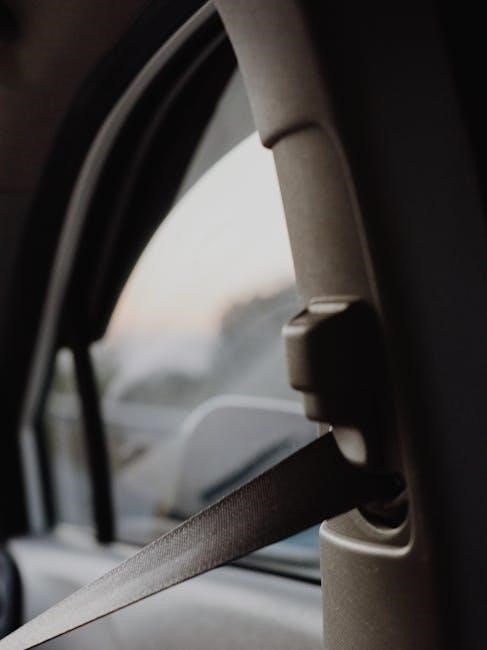Safety First car seat instructions provide guidance on installation and use, ensuring a safe ride for children, with easy-to-follow steps and videos available online for added convenience always helping parents.
Overview of the Safety 1st Car Seat
The Safety 1st car seat is a versatile and safe option for parents, designed to provide a comfortable and secure ride for children. The seat is compatible with all car models and can be easily installed in less than five minutes. The Safety 1st car seat is also known as a child restraint, and it is essential to follow the instructions carefully to ensure proper installation and use. The seat comes with a removable cup holder, making it great for growing families and carpools. The Guide 65 Convertible Car Seat by Safety 1st is a popular choice among parents, as it provides a perfect fit in smaller cars and leaves more room in larger vehicles. The seat is designed to fit three seats across in the back of most vehicles, making it an excellent option for families with multiple children. Overall, the Safety 1st car seat is a reliable and convenient choice for parents who want to ensure their child’s safety while traveling. The seat’s features and design make it an excellent investment for any family.

Installation Instructions for Safety 1st Car Seat
Installation requires careful attention to detail, following specific steps and guidelines always provided by Safety 1st for a secure and proper installation process every time.
Rear Facing Installation
Rear facing installation is a crucial step in ensuring the safety of children, and Safety 1st provides detailed instructions to facilitate this process. The car seat should be placed at a 45-degree angle, with the baby’s head positioned in a way that allows for easy breathing and comfort; To achieve this, the seat can be adjusted accordingly, and the harness straps should be tightened to secure the child in place. It is essential to follow the manufacturer’s guidelines and recommendations for rear facing installation, as this will help to prevent any potential risks or hazards. By installing the car seat correctly, parents can have peace of mind knowing that their child is safe and protected while traveling. The Safety 1st car seat is designed to be versatile and easy to install, making it a popular choice among parents. With its user-friendly design and clear instructions, the rear facing installation process can be completed quickly and efficiently.

Forward-Facing Mode Installation
Forward-facing mode installation requires careful attention to detail, following Safety 1st instructions for secure and proper placement always ensuring child safety and comfort during travel in vehicles.
Positioning the Car Seat

To ensure a safe and secure ride, positioning the car seat is crucial, and Safety 1st provides guidelines to help parents achieve this. The car seat should be placed in the back seat of the vehicle, as this remains the safest area for young passengers. When installing the car seat, it is essential to follow the manufacturer’s instructions and take into account the type of vehicle and seating configuration. The car seat should be positioned at a 45-degree angle to ensure the child’s head is protected and comfortable. Additionally, the car seat should be secured tightly to the vehicle seat using the LATCH system or seat belt, and the harness straps should be adjusted to fit the child snugly. By following these guidelines, parents can ensure their child is safe and secure while traveling in the vehicle, and the car seat is positioned correctly to provide maximum protection. Safety 1st car seats are designed to be versatile and easy to install, making it simple for parents to position the car seat correctly and provide a safe ride for their child.
Installation Without Base
Installing a Safety 1st car seat without a base is a viable option, and the manufacturer provides clear instructions on how to do so. The car seat can be secured to the vehicle seat using the lap belt or lap/shoulder belt, and it is essential to follow the vehicle’s owner’s manual for specific instructions. The LATCH system should not be used in conjunction with the vehicle’s lap/shoulder or lap belt. When installing without a base, it is crucial to ensure the car seat is tightly secured to the vehicle seat to prevent any movement or shifting during travel. The car seat should be positioned at the correct angle, and the harness straps should be adjusted to fit the child snugly. Safety 1st car seats are designed to be easy to install, and the manufacturer provides resources, such as videos and guides, to help parents with the installation process. By following the instructions carefully, parents can ensure a safe and secure installation without a base. This installation method is convenient for families who need to switch the car seat between vehicles.

Assembling the Safety 1st Convertible Car Seat
Assembling the car seat requires feeding the buckles metal retainer through the seat pad opening carefully always following instructions.
Step-by-Step Assembly
To assemble the Safety 1st Convertible Car Seat, start by reading the instruction manual carefully and watching any available online videos for guidance. The process involves several key steps, including attaching the seat pad and harness straps, and ensuring all components are securely in place. It is essential to follow the manufacturer’s instructions to guarantee the seat is assembled correctly and safely. The assembly process is designed to be straightforward, but if you encounter any difficulties, do not hesitate to contact the manufacturer’s customer support for assistance. By following the step-by-step assembly instructions, you can ensure your child’s car seat is properly installed and ready for use, providing a safe and comfortable riding experience. The Safety 1st Convertible Car Seat is designed to be easy to assemble and use, with a focus on safety and convenience, making it an excellent choice for parents and caregivers. Always refer to the instruction manual for specific guidance on assembling the car seat.
Adjusting the Harness Straps
Adjusting the harness straps on the Safety 1st Convertible Car Seat is a crucial step in ensuring a safe and comfortable fit for your child. The harness straps should be adjusted to fit snugly around your child’s body, with the straps lying flat against their shoulders and chest. To adjust the straps, locate the adjustment mechanism and follow the manufacturer’s instructions for loosening or tightening the straps as needed. It is essential to check the fit of the harness straps regularly, as your child grows and develops. The Safety 1st Convertible Car Seat features a user-friendly harness adjustment system, making it easy to achieve a secure and comfortable fit. By following the manufacturer’s guidelines and adjusting the harness straps accordingly, you can provide your child with a safe and enjoyable riding experience. The harness straps play a critical role in protecting your child in the event of sudden stops or accidents, so it is vital to adjust them correctly. Always refer to the instruction manual for specific guidance on adjusting the harness straps.
The Safety 1st car seat instructions provide a comprehensive guide for parents to ensure a safe and comfortable ride for their children. By following the instructions carefully, parents can rest assured that their child is protected in the event of an accident. The instructions are designed to be easy to follow, with clear diagrams and step-by-step guides to help with installation and adjustment. It is essential to read and understand the instructions before using the car seat, as this will help to prevent any mistakes or errors. The Safety 1st car seat is a reliable and trustworthy choice for parents, and by following the instructions, they can have peace of mind knowing that their child is safe. The instructions are available online, and parents can also watch video tutorials to help with installation and adjustment. Overall, the Safety 1st car seat instructions are a valuable resource for parents, providing them with the knowledge and confidence to keep their child safe on the road.

